Forest Hills Stadium has a deeply rich history that we celebrate. We've partnered with Michael Perlman, local Forest Hills Stadium historian, on this History Blog to dive into the moments that have made this renowned landmark in Queens what is it today.
Michael is the author of "Legendary Locals of Forest Hills and Rego Park," and Chair of Rego-Forest Preservation Council. He works as the coordinator of Forest Hills Tree Giveaways and is also a member of the Four Borough Preservation Alliance, Queens Preservation Council, Central Queens Historical Association, and the Committee To Save The Forum Diner/Cheyenne Diner/Moondance Diner.
- QUEENS' OWN SIMON & GARFUNKEL: A TIMELESS DUO AT FOREST HILLS STADIUM
- FIFTY YEARS AGO: THE BEE GEES AT FOREST HILLS STADIUM
- FANS REMINISCE – BARRY MANILOW AT FOREST HILLS STADIUM IN 1978 AND 1980
- DAVID BYRNE & TALKING HEADS: IT’S BACK TO THE 1980S AT FOREST HILLS STADIUM
- WHEN THE BEATLES LANDED AT FOREST HILLS STADIUM
- SPOTLIGHT ON FRANK SINATRA AT FOREST HILLS STADIUM
QUEENS' OWN SIMON & GARFUNKEL: A TIMELESS DUO AT FOREST HILLS STADIUM
POSTED: MARCH 7, 2019

It is no surprise that their high school yearbook, The Forester, featured Paul F. Simon's passion as chorus (alongside law) and Arthur Garfunkel's passion as music. At 15, they composed their earliest party tune sensation "Hey Schoolgirl" in less than an hour, and it can be considered a spinoff of the Everly Brothers' lyrics and harmonies of "Hey Doll Baby." It was performed throughout Queens. "I saw them in the Forest Hills High School auditorium when they were nicknamed ‘Tom and Jerry,' and they sang their first record, Hey Schoolgirl," said classmate Helen Goldbeck Hughes. "I have the 45 rpm record of that song, and also a CD of their greatest hits, which I play in my car all the time." She continued, "Paul and my brother were friends and in the same fraternity at Queens College, and even attended Brooklyn Law School at the same time, but Paul didn't last very long. He had much bigger fish to fry!" Art Garfunkel was a graduate student at Columbia University.
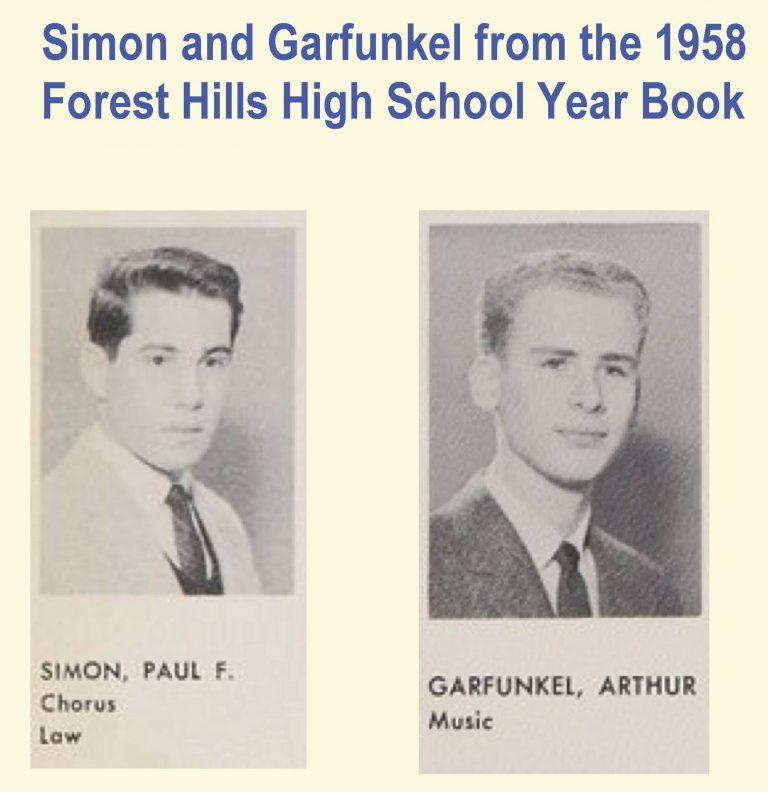
In early 1968, Paul Simon told the Union-Sun and Journal, "We're not trying to alter anything, but pop music has become a prime medium for making some comment about the world for a large audience," in response to their music's theme comprised of alienation, loneliness, and lack of communication. Simon & Garfunkel are often referred to as folk-rock artists, but in a mutual statement, they expressed "We just sing about the things we see going on around us. There are really no labels for it." Paul Simon would write the music and lyrics, and Art Garfunkel would focus on vocal arrangements. Referring back to when they were 13, Paul Simon said, "We used to play stickball together, and then we were both interested in music, so we began singing."
During their teen years, they began writing music and scored a Top 50 hit. Under Columbia Records in 1964, their first album was "Wednesday Morning, 3 AM." Their signature folk-rock song, "The Sound of Silence," became the No. 1 song in America, and they were en route to stardom! It was followed by the release of their 1966 album, "Sounds of Silence." That same year, "Parsley, Sage, Rosemary and Thyme" was released, featuring "Scarborough Fair," and in 1968, their album "Bookends" featured hits such as "Mrs. Robinson" and "A Hazy Shade of Winter." Their 1970 album "Bridge Over Troubled Water" featured the title track, in addition to other memorable tunes including "Cecilia" and "El Condor Pasa."

In 1966, Simon & Garfunkel were a second billing to The Mamas & The Papas, and Dan Daniel, the WMCA "Good Guy" was the host. In addition to visiting or calling the Festival box office in Station Square at BO 1-0600, fans could purchase tickets at all Alexander's department stores such as the Rego Park branch, as well as all Gertz stores. "For my 15th birthday, my brother David took me to see Simon & Garfunkel at the Stadium, and they were great, of course," said Sandy Goldbeck King. She reminisced, "In the midst of their set, they revealed that Paul wrote ‘Red Rubber Ball,' a hit song recorded by The Cyrkle. My brother and Paul were good friends in high school and college, so after the concert, we attended a party at Paul's parents' home. I got their autographs, and before we left, Paul played for us a tape recording of a song they had just recorded, ‘Scarborough Fair,' and the rest is history." David passed away last year. "Among my many cherished memories of my brother, that night will forever burn bright," she continued.
In August 1967, The Doors opened, but started late due to their loss of instruments on their flight. They borrowed instruments and made an impact upon many concertgoers with wildly excited solos with an intense sound as a group. However, after some booing, a main attraction was Simon & Garfunkel who promised "to do them all" as they made an entrance. Nevertheless, as the concert was underway, fans belted out song titles in need of reassurance. A review read, "Introduced as ‘the most literate, articulate' act in the world, theirs is certainly an unusual style in a time of garbled lyrics and slurred speech. From the Paul Simon songbook, each of the tunes features a phrasing, imagery and statement that could be shelved with poetic classics of literature – and the twosome's clear and almost too pure pronunciation is unique among present trends." Their over an hour act featured two encores. Program numbers from their best-seller "Sounds of Silence" included "Fakin' It" and "Dangling Conversation."Other titles were "Blessed" and "Poem On The Underground Wall." Although dominated by the theme of loneliness, the program featured a satirical "At The Zoo" and comic relief in "Punky's Dilemma."

South Florida resident Elliot Pollack was raised in the Rego Park Crescents and was a 1967 Forest Hills High School graduate, who attended the 1967 concert with fellow graduate and girlfriend at the time, Marilyn Leider. He reminisced, "The Doors opened the concert by playing the long version with instrumentals of ‘Light My Fire,' which we would hear over and over on WABC and WMCA. They were booed by the crowd because those there were mostly folk music fans. Simon and Garfunkel were local heroes, and the conservative attitude of Forest Hills definitely did shine through. People wanted to mellow out and not listen to hard rock head music. They were delighted when Simon and Garfunkel finally came on."
Wayne Brown, who once resided locally in the Anita Apartments and Saxon Hall and later in Las Vegas, has been musically inclined from early on. He was in a band with John Cummings, later of the Ramones, and won "The Battle of The Bands" at Forest Hills High School. He reminisced, "I attended the 1967 concert at 16. I was a Forest Hills type of hippie at the time, possibly wearing bell bottoms and Beatle boots. The Doors had a song called ‘The End,' and that was when everyone applauded, since they couldn't wait to hear Simon & Garfunkel. Their music is original and they have beautiful harmonies. Their music speaks for itself. Today I own all their albums."
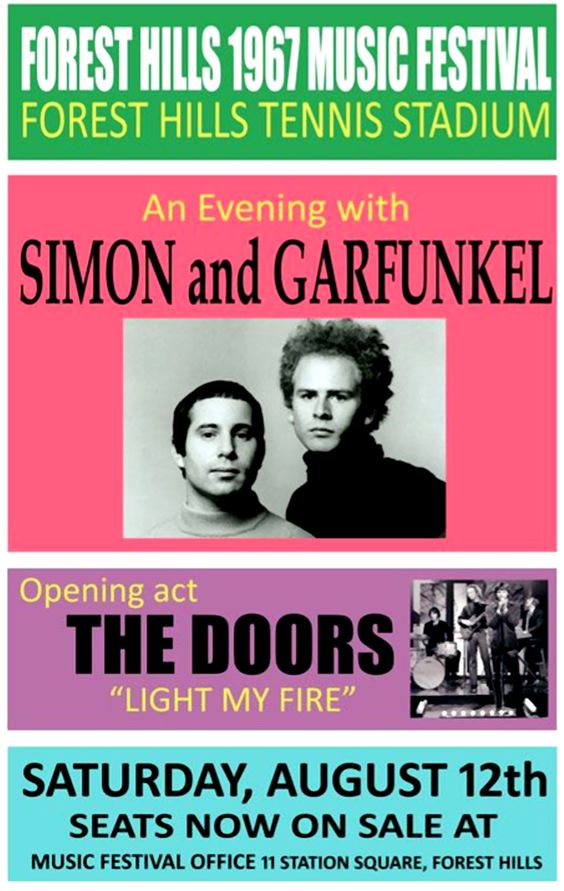
Class of 1967 Forest Hills High School graduate Liz Lacob lived around the corner at 68-43 Clyde Street, and currently resides on the Upper East Side. In 1967, her boyfriend treated her to tickets, but did not consider it to be a "big show" while thinking of further established artists such as The Beatles and The Rolling Stones, who appeared on the same stage. She said, "My feelings changed during that show, and it was one of the first times that I was ever being moved by the words they were singing. Of course ‘The Sound of Silence' was their big radio hit, but when they sang ‘April Come She Will,' you could have heard a pin drop, and perhaps right there a different kind of folk-rock was born."
Until that point, Lacob's experience with folk-rock in Forest Hills encompassed Peter, Paul & Mary and Trini Lopez. She explained, "When they talk about Bob Dylan with his electric guitar and backed by The Band, they often don't realize that the sound was very rough and not at all what we think of as folk-rock today. The idea that words could be more important than the beat became really clear that night, as we sat transfixed listening to them. We were used to bands with loud electric sounds and drums, and not to two guys with a guitar. Their sound was pure, the guitar soft, their voices harmonized, and there was no need to clap along and no audience members were singing. Everyone was quiet and listening to the words; so different from what anyone else was doing at the time. They were incredible!"
After the concert, her boyfriend and a neighborhood friend George Pressman returned to her home to reflect upon their experience. She recalled, "George said ‘Let's go back and meet them, and I replied ‘George, don't be ridiculous! We walked back to the main entrance which by now was quiet and empty, and sure enough, Simon & Garfunkel were standing right there like two guys from the neighborhood! No crowds, no agents, no security, so we walked up, and started talking about how wonderful the show was and shaking hand. Paul Simon was sort of aloof and looking away, while Art Garfunkel was just as enthusiastic as we were."
One attendee of the 1968 concert was Jay B. Silverstein who attended with his Karen C. Silverstein, his wife. "It was the second time we had seen them and enjoyed both concerts. A real standout was when Garfunkel said, ‘When I heard we were playing Forest Hills, my first thought was, who can I ask for a date?' It went over big!"

"It was my first real concert, there were over 14,000 people in attendance, and it was mesmerizing," said John Klopotowski, who was raised in Paterson, NJ and later relocated to Oakland, CA. Some of his most memorable titles from the 1968 program were "Fakin' It" (which he called a surprise), "Mrs. Robinson" (another surprise that was a major hit), "For Emily, Whenever I May Find Her," "April Come She Will," and "The Dangling Conversation." He also recalled the incredibly powerful song, "The Sound of Silence," and a sing-along tune, "The 59th Street Bridge Song." As a birthday gift, he was treated by his older brother, who also brought along his girlfriend. "At the time, I was playing guitar for nearly one and a half years, and idolized Paul Simon. I wondered if there would there be backup musicians, would it sound like the records, or would it be more like the first album featuring both of them alone. Well, it was just the two of them for approximately two and a half hours with four encores. Their voices were pure, and Paul played beautifully." He gave the duo credit for calling out their engineer in the audience, Roy Halee.
He continued, "When we got back to the car, I said ‘I promise to practice the guitar diligently until I'm as good as Paul Simon!' I'm not sure if I accomplished it, but I'm still playing. They were both amazing singers. Paul was a superb guitarist and is better now, and their writing showed real depth. They gave a young man just turning 13 a sense of real artistic quality that persists to this day."
Photos taken by fans must have been a novelty in 1968. "Going to a concert back then was about the pure experience of the event and the music, and then reliving incredible memories," he said.
In a July 1970 concert, Paul Simon wore a striped shirt, blue jeans, and a New York Yankees cap, and Art Garfunkel sported a matching pair of blue jeans and a worn button-down shirt in the spirit of Forest Hills. The first half consisted of numbers such as the opening number, "The Boxer," "The 59th Street Bridge Song (Feelin' Groovy)", "America," "El Condor Pasa, "Fakin' It," and "Homeward Bound." As for the opener, Cash Box magazine read: "I am just a poor boy, though my story's seldom told… I have squandered my resistance, for a pocket full of mumbles…" It then went on to say, "With a little imagination, you can see the similarity of the song and their childhood beginnings in that very same Forest Hills. So that was just the start of one of the finest concerts nine dollars could buy." The main emphasis of the second half was solo numbers was a top seller that was considered Art Garfunkel's finest solo, "Bridge Over Troubled Water," which resulted in a standing ovation. The review read, "After a set of encores, the show ended just as strangely as it had started, with the boys just walking off. They came back to take bows, with sheepish grins on their faces as if uncertain as to whether the crowd enjoyed them. They are unequaled by any other act around and they know it!"
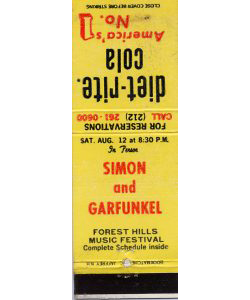
Karasek explained, "Listening to Simon & Garfunkel was like having older, thoughtful siblings that offered great advice about life, and amplified common experiences. At Forest Hills Stadium, it was like a giant family gathering in this way. In the 1990s, I played ‘Sounds of Silence' for my son who was the same age I was when I first heard them, and he shouted ‘No one writes music like that anymore!'"
Some of his favorite program numbers include "The Only Living Boy in New York," "The Boxer," and "Bridge Over Troubled Water." He said, "I've come to love Paul Simon's later work too, including everything on Graceland and beyond. As a performer of world music, I especially relate to how he has explored different cultures. I also attended their shows in Central Park, and thought their performances were amazingly flawless for live shows." Today he is writing a book on various past experiences such as this one.
Another fan, Elliott Lercher, who was raised in Rego Park, attended with Forest Hills High School classmate Harvey Hirsh in 1970. "Their lyrics and harmony made the duo a success, and the audience was electrified. For their final number, ‘Bridge Over Troubled Water,' they told the audience to light a light, and everyone took out lighters."
FIFTY YEARS AGO: THE BEE GEES AT FOREST HILLS STADIUM
POSTED: SEPTEMBER 18, 2018
This summer is the half-century mark since the Bee Gees, an Anglo-Australian quintet, were a smash at the iconic Forest Hills Stadium. On Saturday, August 10, 1968 at 8:30 PM, the Gibb brothers, Maurice (1949 – 2003), Barry (born 1946), and Robin (1949 – 2012) performed, along with two Australian members, Colin Petersen (born 1946) and Vince Melouney (born 1945) at the annual Forest Hills Music Festival, which originated eight years earlier. The Bee Gees were inducted into the Rock & Roll Hall of Fame in 1977, and in recent years were considered best-selling artists worldwide, with over 220 million record sales.

Some romanticism made a comeback for the youth pop scene, thanks to the Bee Gees. Robert Shelton, a well-known music critic of The New York Times praised the Gibb brothers and their two side men for their undeniable charm. He then wrote, "After years of so much hard-driving, outrageously voluminous rock, the Bee Gees bring a sensitivity and a disingenuousness to pop that is quite without parallel. Some echoes of the vocal style of The Beatles and the Everly Brothers can be discerned, even though the Gibbs were working as a child act before those groups appeared."
Tickets could be purchased at the minimal price of $5.00. "Presenting The Bee Gees," a souvenir program was available for concertgoers, and it offered a list of successes – "Voted Best New Group 1967 by the 'New York Musical Express'; World's Brightest Hope by 'Disc and Music Echo'; World's Most Promising Group by '16' magazine; and Radio Luxembourg's Golden Lion Award for the Best Record of 1967 – 'Massachusetts.' They have won awards in America, Australia, and Germany, as well as their many British trophies." It then read, "The Bee Gees are truly an international group. Never before has any act had such instant and overall appeal. Apart from their three Golden Discs – 'Massachusetts,' 'Words,' and 'World' – the Bee Gees have notched up 27 No. 1 hit records in 15 countries. Not bad work for a group that's been together for just over a year!"
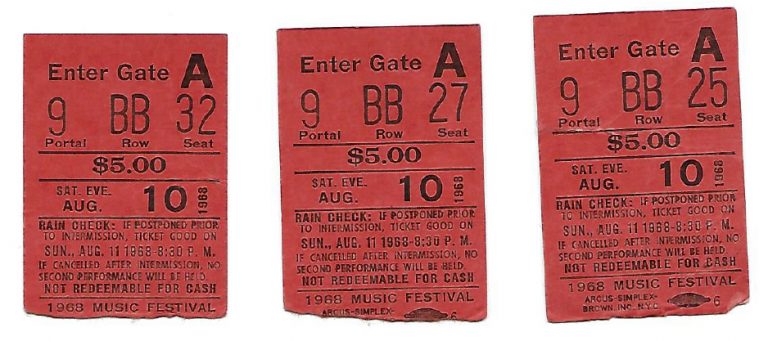
Another excerpt read, "The Bee Gees begin their first million-dollar tour of America. For more than a year, fans of the group in the US have had to wait for their idols due to their commitments in Europe, but now the dates have been set – the Bee Gees are on the way. Already their records are smash hits there – just wait for them to take the United States by storm!"
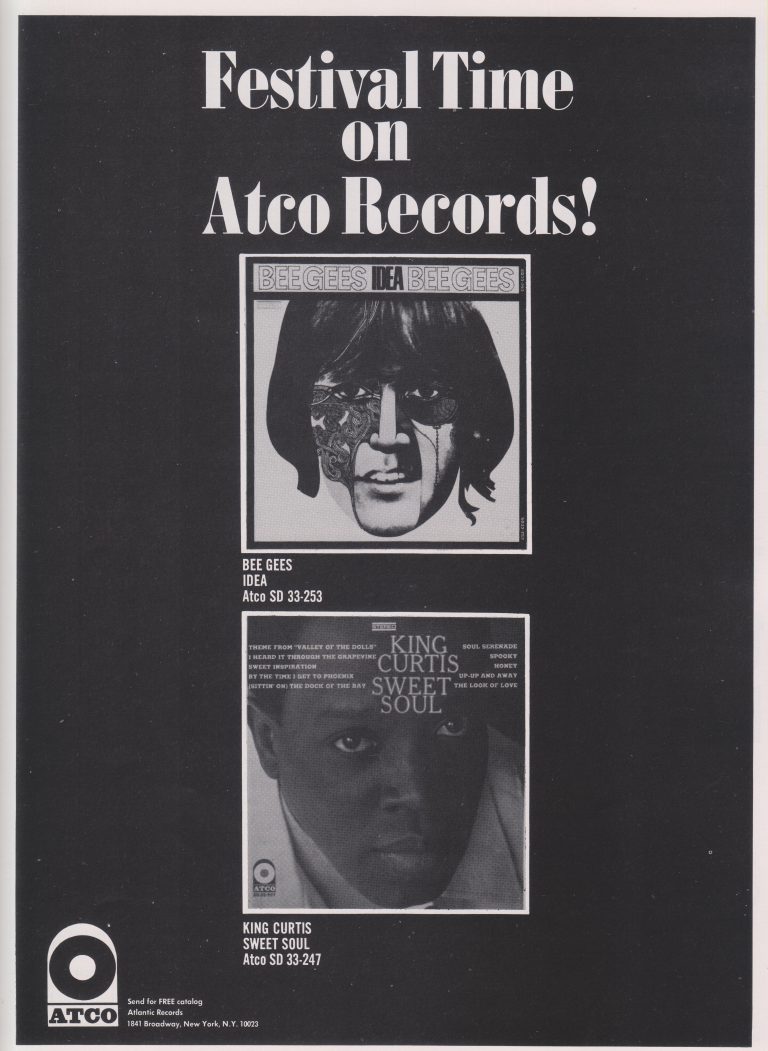
East Village resident Eric Paulin, who once resided at 1 Ascan Avenue, and was in many bands with his brother between 1964 and 1974, was a huge fan of Nazz, a hard rock quartet as an opening act. "They really rocked, and of course guitarist Todd Rundgren, who was very big into the 1970s and 1980s. Today I can say that I saw him with the group that brought him to public attention. The Nazz had a cool semi-psychedelic concept and not over-produced pop music, but more organic and raw, almost like The Who." One of their most well-regarded numbers remains "Open My Eyes."

Stigwood once stated, "The Bee Gees' original breakthrough in the states was the most exciting thing. The concert I most enjoyed was when they played at Forest Hills Stadium. They were using their full orchestra, and it was an outdoor concert. It rained, but they played an hour and a half in the rain. Not one person in the audience moved. I've never seen a reaction at a concert like that. The audience wouldn't let them off the stage, and gave them a 30-minute ovation."
Somerset County, New Jersey fan Karen D'Ambrosio, who lived in Ozone Park, New York at the time, was thirteen years old, and attended with her friend Mary from elementary school and both of their mothers who were also fans. After attending The Monkees' concert in 1967, she was very excited to return for another concert experience. She said, "I couldn't wait to hear the Brothers Gibb sing live. My friend was a huge Maurice fan, and she screamed his name throughout the evening." Her favorite performance numbers were "Massachusetts," "New York Mining Disaster 1941," and "Holiday." "The beautiful harmonies of the Bee Gees, along with the other band members Colin and Vince as a trio or as solo artists, are undeniable," said D'Ambrosio.
She continued, "Their music withstands the test of time, whether it is their early work, disco era, or more recent works, and their songs are still in rotation on terrestrial and satellite radio. Hearing their older songs brings me back to my early teenage years. I have listened to them regularly since 1968, and I am partial to their pre and post disco works." In addition to her memories that she will always be grateful for, ticket stubs from that evening serve as a keepsake, in addition to a Bee Gees program that she purchased.
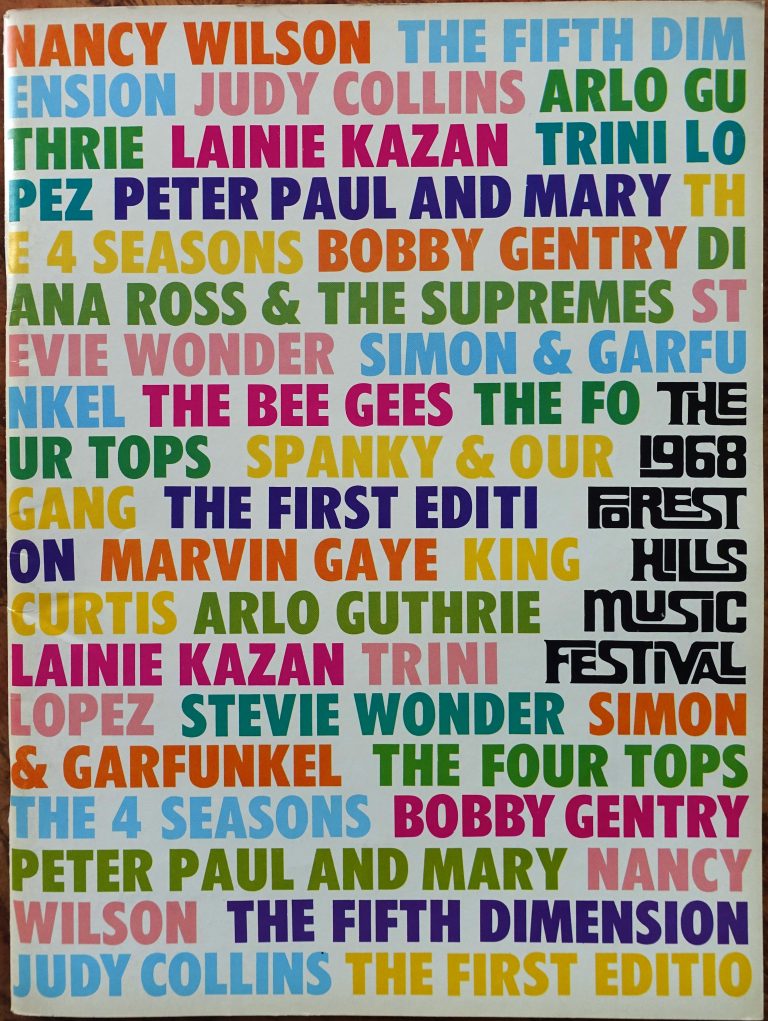
"I knew the Bee Gees would be backed by a full orchestra, which was pretty much unheard of at that time, and it would result in their music sounding very close to the way the songs were recorded," said Oliver.
He reminisced, "The full orchestra resulted in a lush sound that complemented the brothers' harmonies. One song that sticks in my mind is Robin Gibb's 'Really & Sincerely.' The audience was totally silent, listening to Robin's vibrato voice. Barry Gibb belted out a stunning rendition of 'Let There Be Love.' When they performed 'I've Gotta Get A Message To You,' it was met with great fan reaction, since it was a huge hit."
Midway through the concert, it began to rain, but did not place a damper on the experience. He explained, "The Gibbs continued singing and the fans reacted with true enthusiasm. I distinctly remember Maurice Gibb getting a shock when he touched his microphone, but the show went on. The Bee Gees enjoyed several standing ovations, and the crowd just wouldn't let them off the stage." He recalled reports indicating as many as 13 curtain calls.
As a Bee Gees fan, Oliver nearly saw them every year they toured, such as in 1979. He reminisced, "I would see the Bee Gees perform at a standing room only concert in Madison Square Garden at the height of Saturday Night Fever!" Nearly fifty years later, he said, "I still listen to their music daily and collect memorabilia including CD's and videos." In his possession is also the 20-page official souvenir program for their U.S. tour. "I feel very fortunate that fans supported the Forest Hills concert. From what I read, with the group being new, many of their concerts were canceled across the country in 1968 due to poor ticket sales. I believe the two that worked for them were in Forest Hills and Anaheim, California."

The evening's finale consisted of Spanky and Our Gang, a 1960s sunshine pop band distinguished by its vocal harmonies, which younger and older generations engaged in. Performance hits included "Brother Can You Spare A Dime," "Sunday Morning," "Like To Get To Know You," "Lazy Day," "Sunday Will Never Be The Same," and "Making Every Minute Count."
FANS REMINISCE – BARRY MANILOW AT FOREST HILLS STADIUM IN 1978 AND 1980
POSTED: JULY 9, 2018
Forest Hills Stadium, which became America's first tennis stadium in 1923, was home to a number of firsts in tennis history including the birthplace of the U.S. Open. It was also adapted into a concert venue in 1960 for the Forest Hills Music Festival, a tradition analogous to celebrating summer. A few of the diverse world-class acts that took the stage in a venue that continues to offer great sight-lines and acoustics includes The Beatles, Frank Sinatra, Donna Summer, Bob Dylan, and Simon & Garfunkel. Also among them is Barry Manilow, who performed on July 28 and July 29, 1978 and returned for a second season on July 25 and July 26, 1980.
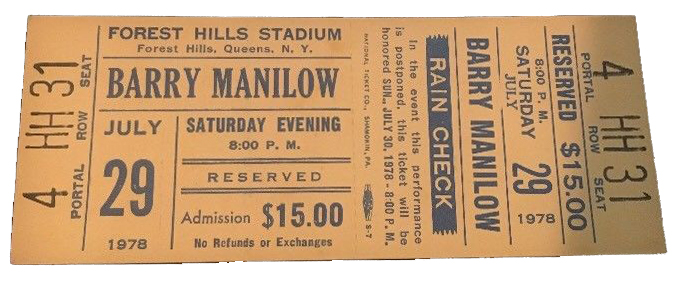
Manilow, who celebrated his 75th birthday on June 17, 2018, was born Barry Alan Pincus in Brooklyn, NY. For over half a century, he has been a music sensation, and has intrigued audiences as a singer, composer, pianist, arranger, and music and theatrical producer. Some of his most memorable tracks which span the generations include "Copacabana," "Mandy," "Could It Be Magic," "I Write The Songs," and "Can't Smile Without You." To date, he has sold over 80 million records worldwide, and released 4 live albums, 32 studio albums, 57 singles, and 15 compilation albums.
In 1978, both of his shows were sold-out, and it marked his return to the spotlight in New York, a year after recording and touring. On a few occasions, he reminded concertgoers that New York is his home. He was praised for tunes that resonated, a great ear, good melodies, much soul and energy, emotional lyrics, and sets of chord changes. Another admirable characteristic was a juxtaposition of pop rock to 1940s-era jump tunes to ballads, and it blended in seamlessly well. At times, he felt that earphones malfunctioned and spotlights were not in focus, but his audience felt that all was under control.
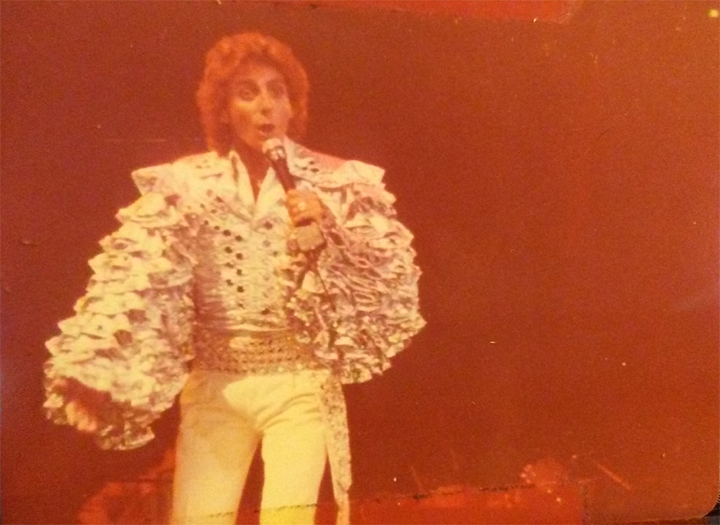
A wide range of fans' experiences are as entertaining as Manilow's colorful performance numbers and spirit, and offer sentiments that can only be found in a memoir. Anita Clark-Fanelli, the mother of NY1 News anchor Roger Clark moved to Forest Hills in 1974, and currently resides in South Florida. She attended a 1978 concert and feels that he does not have to engage in much more than singing, which captures the attention of his audience. She reminisced, "Barry Manilow had the stadium rocking and rolling. The props and costumes for ‘Copacabana' were the best, and of course he had the crowd going wild. I can vividly remember people dancing and singing in the stands. My friends and I sang along to all songs, and it's amazing that people continue to remember the lyrics, since great music and lyrics bring back the best memories."
Shelbyville, TN resident Barbara G. Lovejoy commuted from Bedford Hills, NY to attend his July 29, 1978 concert and on both nights in July 1980, when she wore a Manilow t-shirt and jeans. She recalled, "The biggest surprise was the ‘Copacabana' number, where Barry came out on a giant conga drum. His mom Edna was there, and was great to talk to." His program included "Mandy," "‘Trying to Get the Feeling Again," "This One's For You," "Can't Smile Without You," "I Write The Songs," and "Weekend In New England," her personal favorite.
Lovejoy created a petit point embroidery of his 1978 concert program, which took 6 months and she found to be very tedious. It eventually landed in Manilow's hands. She reminisced, "In 1980, Barry and his assistant Paul Brownstein knew who I was after sending him several of my needlepoints and drawings. Paul later told me Barry hung it in his office." Several years later, a crowning moment transpired. On December 5, 1997 at a Tampa, FL concert, she was selected to sing "Can't Smile Without You" with Manilow on stage. "The second I told him my name, he knew who I was, and called me ‘an old friend fan of mine,' and that made my Christmas!"
Manilow's music withstands the test of time. She said, "He appeals to the masses, since his songs reflect love when it's good and when it goes bad, and people can relate to that."
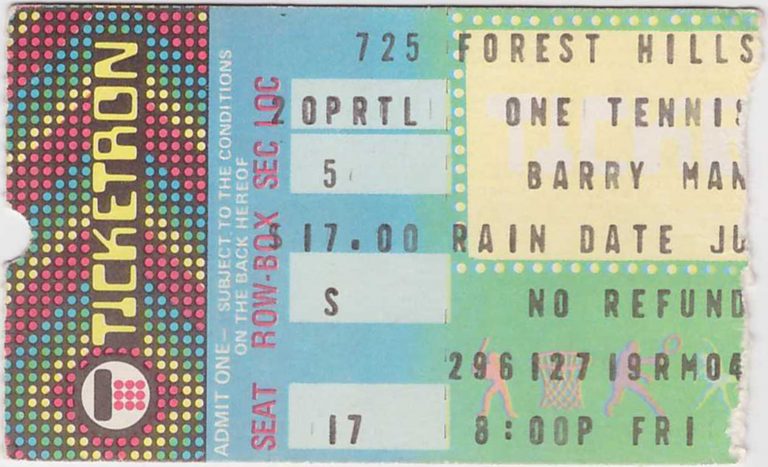
Medford, NY fan Gina Belmonte lived in Center Moriches, NY at the time of the July 29, 1978 concert, and was 14. The memories of her first Manilow concert kept flooding in, and now she is up to her 91st. "I was the only kid in school who loved him, but I didn't care. I sent my aunt to A&S, which was Ticketmaster, and she waited hours. I had a floor seat, and my aunt and mother got nosebleeds. I made Barry a piano pillow, and talked every security member into taking it to him. Barry and Lady Flash (his backup group) came on stage, and began performing ‘Beautiful Music.' When the rain came, Barry said he would come down and be with us if we got soaked, and then someone passed out ponchos. I fell in love right there! He did ‘Boogie Woogie' with Lady Flash and danced, and of course my favorite, ‘Could It Be Magic.'" She can still see the audience singing "Copacabana" en route to the train after the 2 ½ – hour concert, and it would take her 30 years to meet Manilow.
"Ever since the first note of ‘Mandy' in the early 1970s, my friend Mary Kate and I fell in love with Barry Manilow," said Syosset resident Linda Fessler Weinstein, who was raised in Merrick. While attending junior high, Manilow was not the most popular among 13 and 14-year-olds. Eventually, their love for him would take a twist. "We bought all his records and every magazine with him in it, and enjoyed our secret. For Valentine's Day 1978, we wrote Barry a Valentine's card. I was in charge of putting it in the mailbox at the school bus stop, but when I went to mail it, it was gone. I must've dropped it on the way. While we were on the bus, a very obnoxious girl started reading it out loud. Needless to say, we were mortified, and the teasing persisted for days." Then they decided to write Manilow a letter, never anticipating a personal reply. Weinstein continued, "He invited us and our moms to be his guest on July 28, 1978, opening night, and sat us with his mom Edna in row E, the best seat in the house! We got to meet record producer Clive Davis. We wore matching white satin outfits, similar to what Barry would wear, and we thought that was cool. I took a picture of Edna." In 2011, she met Barry at a CD signing and took along that photo. "I didn't expect this, but he asked if he could have it, and I said ‘sure!'" To date, she has attended 73 performances. Considering him iconic, she said, "Barry always says he strives to make people feel. Barry makes me feel."
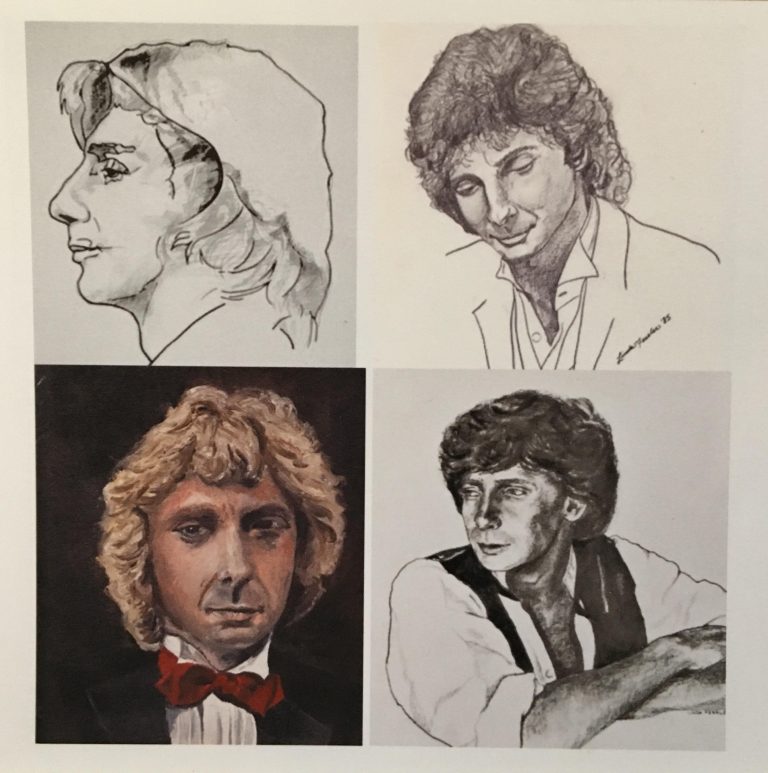
New City resident Marcy Scolnick Lawrence recalled a few standout memories on July 28, 1978. She explained, "On a beautiful, clear summer night, he was so cute and wore a colorful calypso shirt during ‘Copacabana.' All six of us friends swayed in unison to ‘Can't Smile Without You.' It was magical!"
New Milford, NJ concertgoer Judy Scioli attended two of his engagements at Forest Hills Stadium in her late teens, and also met his mother, Edna, who she recalled as sweet. Scioli said, "I was there the night the lights went out on July 26, 1980. There was a spotlight, but we didn't care, as long as we could see Barry. We would have listened to him in pitch darkness. He was the only thing illuminated, and he went on with the show like a pro!" She continued, "Years later, he autographed a CD, and I've been blessed to meet him a few times. It's been a lifelong thing."
"I filmed the whole bloody concert (July 28, 1978), but my son taped over it for a hockey game," said Michele Yohanna, who commuted from Rye, NY and currently resides in Carmel, NY. She attended with her husband, daughter, son, and two nieces. "By today's standards, the price was almost free," she chuckled, referring to an estimated $7.50 ticket. "I wanted to get good shots of Barry, so I moved down to the front where the press was, but no one ever asked me for credentials. They saw that camera, and figured I was just part of the group."
She explained what also made the concert memorable. "Barry came on stage with his fly open, and was so embarrassed when he was told to zip up. Also, there was a small fire on stage, since some wires ignited."

Also in attendance on July 28, 1978, in addition to July 26, 1980 was Bedford, NH fan Elena Abbene, who was raised in Floral Park, NY, attended Queens College, and later lived in Coram, NY. She has seen him at least 80 times, and in the 1980s became a lifetime member of the Barry Manilow International Fan Club. "It was a one-time fee of $199 at the time, and it paid off, and now they're probably sorry for it," she chuckled.
"Whenever he produced a new album, I bought it," said Abbene, and today her collection consists of an approximate 60 albums not including 8-tracks and cassettes alongside many t-shirts and pins. She also owns copies of his books including "Sweet Life: Adventures on the Way to Paradise" (1987), as well as VHS recordings of his TV appearances including his "Copacabana" (1985) TV movie.
Abbene sat in the nosebleed section with several friends. "Barry had a woman come up on stage and sing ‘I Can't Smile Without You.' Anybody that I've ever seen who goes up there is in disbelief and excited, and to find out that he played the accordion and brought it out on stage was another surprise." She recalled most patrons wearing bell bottoms or jeans.

Abbene was pregnant with her daughter at the time of the 1980 concert, and the use of 8-track tapes that looped would prove beneficial shortly after. "When she was born, she wouldn't sleep through the night. My husband and I tried every other artist, but the only thing that would soothe her is a Barry Manilow song, and she would stop crying."
Abbene especially cannot forget Manilow's ballads such as "Week in New England," "I Made It Through The Rain," "If Tomorrow Never Comes," and especially "I Am Your Child," which one of her daughters danced to with her husband at her wedding. She explained, "His ballads get you in your core, and even sad songs make you feels so good inside." His music transcends time and offers something distinctive for nearly everyone. "I attended two concerts last year, and the audience ranged from young girls to great-grandmas, and even men. I don't have to drag my husband. When Barry would talk and tell stories about his childhood, he made you feel as if he was talking to you. At his concerts, it's always like you're with one big family or talking to an old friend, since everyone has the same feelings about him."
DAVID BYRNE & TALKING HEADS: IT’S BACK TO THE 1980S AT FOREST HILLS STADIUM
POSTED: MARCH 29, 2018
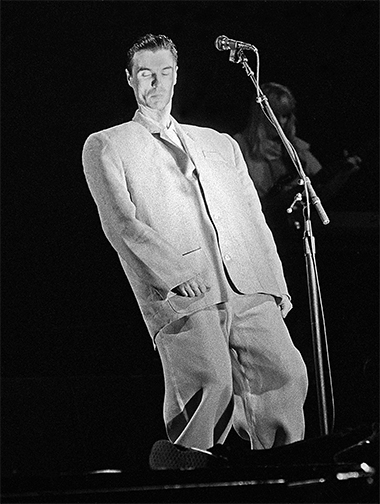
Byrne is the recipient of an Oscar and a Grammy for his soundtrack to “The Last Emperor” film in 1988, and Talking Heads was inducted into the Rock & Roll Hall of Fame in 2002.
Talking Heads first appeared at Forest Hills Stadium on Saturday, August 21, 1982 at 8 PM and concertgoers could purchase a ticket that ranged from $12.50 to $17.50. Then on Friday, August 19 and Sunday, August 21, 1983 at 8 PM, Talking Heads rocked the stadium stage for another season, where tickets were available at $15 in advance or at $17.50 on the day of the show.
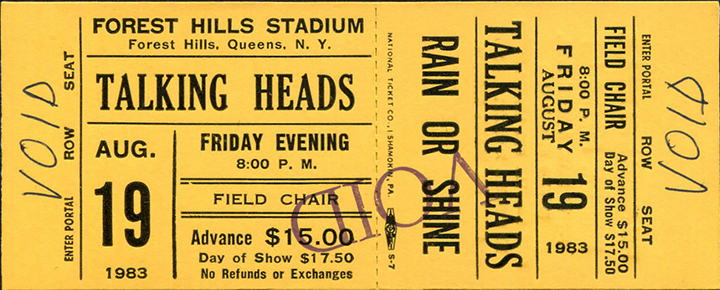
Thirty-five years later, it will be history-in-the-making on September 15, 2018, as WFUV and Madison House Presents offer the opportunity for David Byrne to appear with Tune-Yards, an art pop, indie pop, lo-fi, worldbeat band founded by Merrill Garbus of New England. Byrne will perform new music from his eleventh solo album, “American Utopia,” which was released on March 9th, and audience members will soon find out if he will perform Talking Heads classics and his memorable solo tunes.

In June 2017, Rolling Stone published “The 50 Greatest Concerts of the Last 50 Years,” and Talking Heads’ “Speaking in Tongues” / “Stop Making Sense” tour, the two-night engagement in August 1983 was featured. Byrne was thought of as somewhat nervous and struggling to dance in his huge white suit, so his dance routine was considered odd. He recalled, “I had to find my own way of moving that wasn’t a white rock guy trying to imitate black people, or bring some other kind of received visual or choreographic language into pop music… I just thought, ‘No, no, you have to invent it from scratch.’” Byrne and drummer Chris Frantz reminisced the 1983 Forest Hills Stadium concerts as a memorable time. Frantz said, “Madonna had just released her first record; she was walking around barefoot. I saw Mick Jagger and Jerry Hall off to the side of the stage; she was dancing, Mick wasn’t.”
The sold-out show of August 19, 1983 is remembered as a two and a half hour engagement on a hot and humid summer night. Distinguishable characteristics of Byrne were his black hair, dark staring eyes, unique dance moves, and his signature oversized white suit. Five additional musicians joined Talking Heads, consisting of an additional keyboardist, a percussionist, guitarist, and two female singers and dancers, which felt like an ensemble. Byrne made a solo entrance on stage, carried a boom box, and began singing the Talking Heads’ earliest underground number, “Psycho Killer.” With each number, the stage progressively became a setting for musicians, and as part of the encore, Byrne sang “Burning Down the House,” their first top ten hit. The stage was then filled with dancers and percussionists among band members.
Among the seventeen performance numbers were also “Thank You for Sending Me an Angel,” “Slippery People,” “Life During Wartime,” This Must Be the Place,” “Once in a Lifetime,” and the Al Green cover, “Take Me to the River.” The second half of the program was noted for its word and slide projections and tricky lighting effects. Two days later, the August 21st concert featured two sets totaling 23 numbers.

David Colton recalled Forest Hills Stadium in the context of other venues of the day. “It was the friendliest of concert venues, a secret musical oasis in an era of seedy Manhattan clubs, gummy movie theaters, and cavernous shows at Madison Square Garden or Nassau Coliseum. Forest Hills was small and suburban, surrounded by trees and the friendly ghosts of tennis history.” Nevertheless, Forest Hills Stadium offered a magnitude force.
He said, “Talking Heads was the opposite of tree-lined streets and hushed tennis courts. They were urban and art-school ironic, and like the best of minimalists such as the Ramones and Patti Smith and the B-52’s, the Talking Heads were joyously funny.”
They attended Talking Heads engagements on several occasions. He reminisced, “It was always in urban settings such as CBGBs, small theaters, or odd Manhattan performance spaces, and usually with a knowing collection of fans, but in 1983, MTV had propelled Talking Heads into a new era of pop and visual storytelling.” They found it delightful to secure a parking space within a few blocks from the stadium, and had uncertain expectations for the evening.
He explained, “To experience the claustrophobic Talking Heads in the open air was strange within itself, but to see Byrne open the show with a tape recorder-driven ‘Psycho Killer’ in the heart of the Queens discos that ‘Son of Sam’ had terrorized just a few years before, was daring and transgressive performance art at its best.”
He found the stadium as the ideal setting for a new iteration of Talking Heads. “Under the stars with a big open stage and a Brazilian-infused underbeat, the Talking Heads were magical and important that night, and when Byrne emerged in the ‘big suit’ near the end, the group’s fusion of relentless rhythm and cutting intellect made for one of the most memorable concerts of their unforgettable run.”
Now David Colton and his wife are anticipating the stadium’s upcoming concert season. He said, “Byrne’s solo career has remained brilliant and essential, even with his long absences from the public eye. A return to Forest Hills shows how important that Talking Heads show 35 years ago was for the group and their legacy.”
Donna Donna, air personality of “Long Island’s Only Classic Rock” radio station, 102.3 WBAB, also had a treasure trove of memories to share. “I’ll never forget the balmy night in 1983 when the Talking Heads electrified the crowd,” she said, prior to calling the fusion of performers, songs, choreography, rhythm, and energy “absolutely hypnotic.” “The performance was exhilarating and the music was so rhythmic, that no one could stay seated,” she continued.

Donna Donna can relive the energy of the moment Byrne took the stage, which heightened throughout. She reminisced, “Byrne alone with the acoustic guitar and a boom box was striking and powerful, but as each member joined the power grew. Finally, when the backup singers appeared and the ‘auxiliary’ musicians including Bernie Worrell of Parliament-Funkadelic fame were added, the full ensemble was assembled, and the power engulfed the stadium like a cyclone that sweeps up everything in its path.”
Donna Donna considers it fortunate that the tour was captured for posterity in Jonathan Demme’s critically-acclaimed concert film, which also bears the title, “Stop Making Sense.”
She explained, “It’s telling that although the Talking Heads released three more albums after 1983’s ‘Speaking in Tongues,’ the band never toured again. It was as if Byrne knew that the ‘Stop Making Sense’ tour would be impossible to top. That’s why it is particularly exciting that after all these years Byrne will return to Forest Hills Stadium with another big band, as in 12 pieces, for a choreographed ‘untethered’ concert that he has called ‘the most ambitious show I’ve done since the ones that were filmed for ‘Stop Making Sense.’”
“Rock shows can often feel disposable and of the moment, but occasionally there’s a show that is clearly something special, which stays with you long afterward,” said Donna Donna.
The 1983 season proved to be a step forward in tying the knot for Talking Heads fans David Marin and his wife Marsha Marin of Westchester County, New York. He recalled, “My future wife and I had our first real date at the stadium on August 19, 1983 for the Talking Heads on their ‘Stop Making Sense’ stage show tour. We worked together, and this was our first time going out to a show. We both lived nearby, so there was something to be said for the convenience. I was living in the Walden Terrace in Rego Park, and my wife lived in one of the alphabetical streets in Forest Hills.”
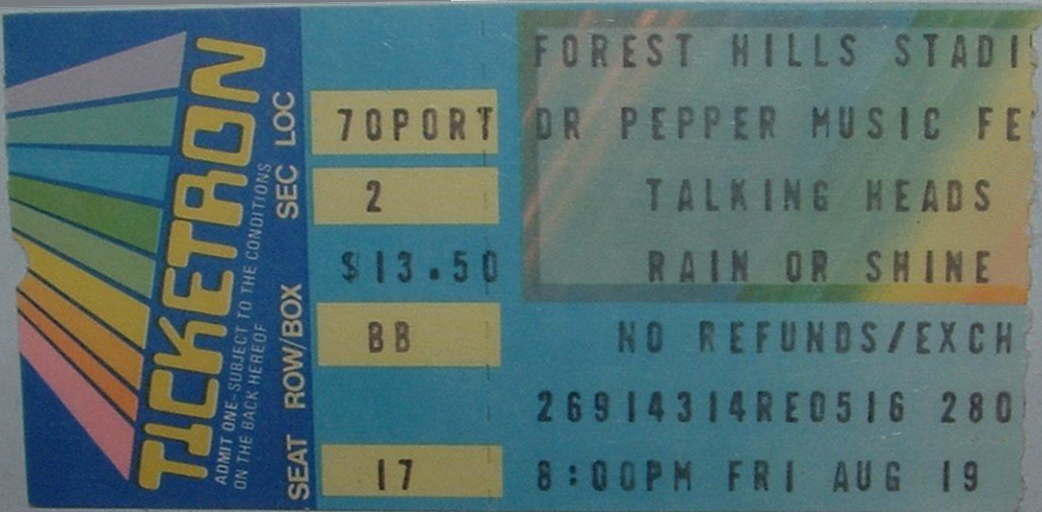
Concertgoer, novelist, essayist, and poet Stephanie Gangi finds it a challenge to separate the Forest Hills concert from the 1984 film “Stop Making Sense, since she is not only a Talking Heads fan, but a Jonathan Demme fan. She said, “The director perfectly captured the feeling of being at the show, since I felt surrounded by like minds, bodies in rhythm, and the inimitable Talking Heads wall of sound.”
Gangi attended the concert with her date. She explained, “I remember it being a communal experience with smart people listening to smart music beyond the radio hits, but even the hits were brainy, extended, and exploratory. It was highly visual and big-seeming. This was music making art, and I could ‘see’ the music, in a way, and of course that was focused by the ‘big suit.’”
Her interpretation was not only that of a suit, but one that “glowed” and “shimmied.” She continued, “It was like a marionette with David pulling the suit’s strings. It was a sophisticated cartoon; maybe an image that pre-dated graphic novel art. It felt like all the tensions of our lives were shaking through David and the suit. Working the suit with the music was performance art I could actually enjoy.”
Gangi recalled the band members enjoying their spot on stage, and especially Tina. “It felt as if they understood that they were in their element and moment, and at their peak.”
She interpreted “Burning Down the House” as if the song went on forever. “It was like a crazy ride with hills, turns, and rest stops.” She continued to reminisce, but in a way the concert seemed timeless. “I remember ‘Girlfriend Is Better,’ since I was in love with my date who turned out to be the love of my life, but is gone now. For ‘I Zimbra,’ the whole joint was up on their seats, dancing. The Talking Heads hold up for me in ways other bands do not, and the music seems the way it was on that night; fresh, exploratory, and smart.”
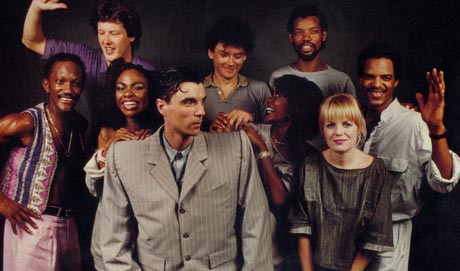
WHEN THE BEATLES LANDED AT FOREST HILLS STADIUM
POSTED: JANUARY 31, 2018
One of the most memorable concerts in the history of Forest Hills Stadium, America’s first tennis stadium and the birthplace of the U.S. Open, was when The Beatles took the stage on Friday, August 28 and Saturday, August 29, 1964. In what was regarded as the “citadel of tennis,” they made quite a landing by helicopter on the grass courts, and over 16,000 fans commanded a chorus of screams each night, and yet thousands more had to be turned away.

The Beatles, born in Liverpool, and comprised of John Lennon (1940 – 1980), Paul McCartney (born 1942), George Harrison (1943 – 2001), and Ringo Starr (born 1940), were nicknamed the “princes of pandemonium,” and embarked on a 30-day tour throughout the U.S. and Canada, earning well over $1 million. This was also a particularly extravagant time to live in or visit Queens, since the Forest Hills Music Festival was in its fifth season, and nearby, the 1964 World’s Fair was in full swing in Flushing Meadows Corona Park.
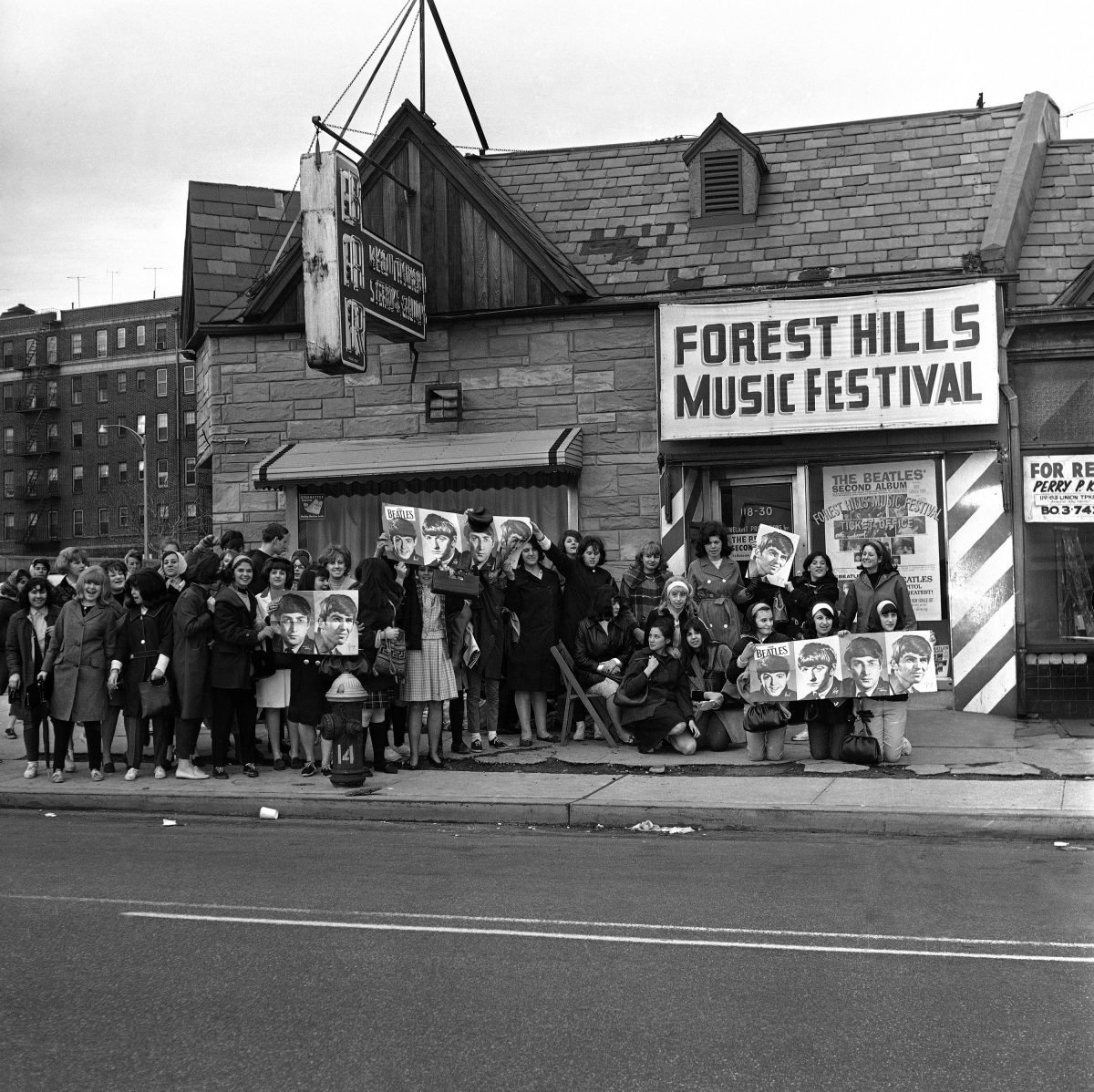
A ticket cost between $2.95 and $6.50, but the experience… priceless! As July rolled around, Beatles fans hoping to obtain free admission would visit a Randforce circuit theatre in Queens or Brooklyn and write in 25 words or less, “Why I want to see The Beatles.” The submission deadline was August 21, and the greater the entries, the greater the chance. If a contestant’s name was drawn, they would find two complimentary tickets in the mail for “The Beatles’ personal appearance.”
Opportunities to win tickets continued. On August 14, columnist Lou O’Neill of the LI Star-Journal Sports Department wrote, “I’d just love to give away a choice pair to the Beatles’ concert. (Wot, that noise is a concert?). But the give-away has one string to it: we gotta help the Mets!” Alongside being a Mets booster, O’Neill made the main qualification of the Beatlemania-Metsomania sweepstakes consist of a 50-word entry. He asked, “Well, you Beatlemanians or Metsomanians, how would you help the Mets?” He went on to say, “The best letter, the best or most novel idea in the opinion of the judges, will win two up-front seats for the Beatles’ bash in Forest Hills on Friday, August 28.”
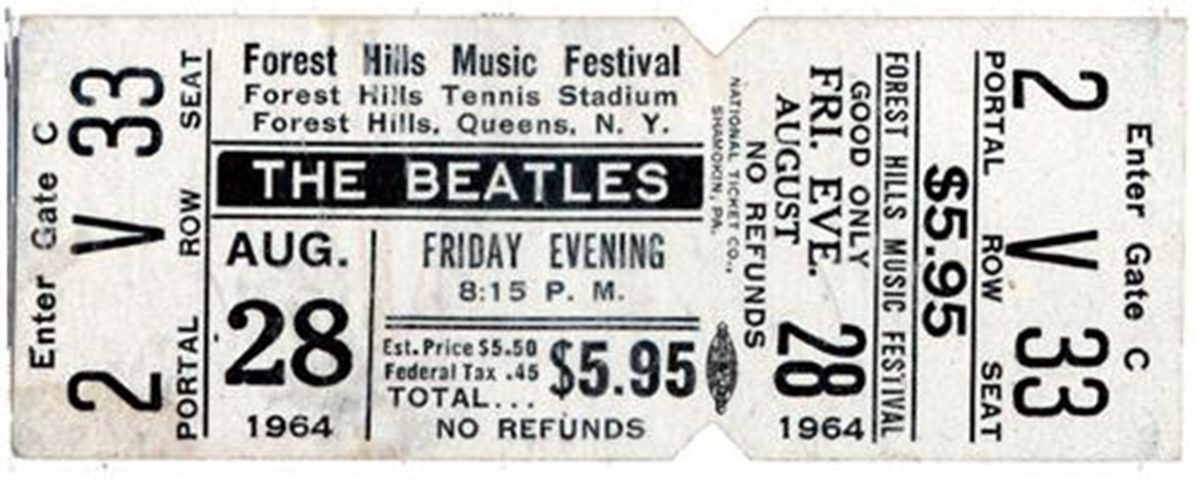
The well-known Alexander’s department store in Rego Park among other branches was in tune with the times. For one week, patrons could purchase Beatles Capitol LP albums at 20 percent off, which included their first album, “Meet The Beatles!” A.S. Beck, a shoe chain, also advertised the 1964 Forest Hills Music Festival to win free tickets.

The Beatles arrived at 2:55 AM on August 28 at Kennedy Airport from Cincinnati, as part of their North American Tour, and had an estimated 3,000 screaming teens, mostly girls who anticipated that very moment. In no more than two minutes, they ran from the plane into their limousine. Police confined the fans to a 30-foot-high observation deck, which was 200 feet away from where the plane landed.
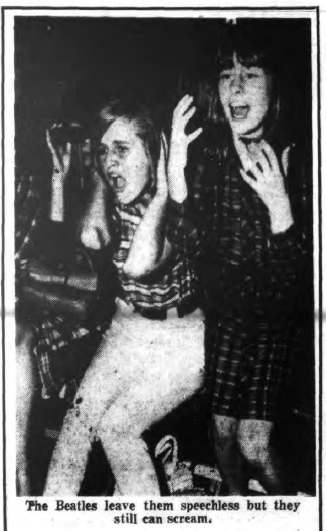
The crowd lingered outside the hotel and heard the broadcast on transistor radios. A deal was made, where anyone who returned the medal would meet Ringo, John, Paul, and George, and in turn, WABC received phone calls from 155 girls who claimed to have the medallion. Fifteen-year-old Angie McGowan was willing to make the sacrifice, arrived at the studio, and handed the medallion to Cousin Brucie. She explained to the Associated Press, “I grabbed him around the neck to kiss him, but I was shoved back into the crowd. Then I looked in my hand. I thought I had a button, but I discovered it was a medal.”
At a press conference, The Beatles praised American girls, American money, American journalists, and ultimately America. Then they stepped back into a limousine to a heliport in lower Manhattan, and en route they were to Forest Hills Stadium, guarded by 200 police officers inside and another 300 officers on patrol in the surrounds. Private detectives were on scene, four ambulances were stationed, and fire hoses were in operation to dampen outbursts that venture beyond. The lineup of over 16,000 fans began much earlier in the day. The Beatles made landfall in a helicopter on grass court G5, and screaming girls nearly produced enough energy to lift the helicopter back into takeoff.
The Beatles’ setlist for each concert consisted of “Twist and Shout” (The Top Notes cover), “You Can’t Do That,” “All My Loving,” “She Loves You,” “Things We Said Today,” “Roll Over Beethoven” (Chuck Berry cover), “Can’t Buy Me Love,” “If I Fell,” “I Want To Hold Your Hand,” “Boys” (The Shirelles cover), “A Hard Day’s Night,” and “Long Tall Sally” (Little Richard cover). The master of ceremonies on the first night was the WMCA Good Guys, and Murray The “K” on the night that followed. The Stan Rubin Orchestra offered pre-show entertainment.

On the first night, one unique attraction was 17-year-old Mary Fuller of Darien, Connecticut, who dreamt to come face to face with George, so dense wooden barriers and police officers guarding the stage, set apart from fans by a 1,000 square-foot open area, proved to be no match. She emerged from the rear, took the stage with bare feet, and she hugged George. The Beatles stopped playing and stared in wonderment until police intervened, leaving their positions unguarded. She said, “I had to see George. It’s very complicated but I had to talk to him about something, and I wanted to make sure to see him.” Another 17-year-old, Al Tarallo of Yorktown Heights, also forced his way on stage, and later explained to officers that he sought to present the Beatles with a painting of them. He said, “I love those guys, and when I was up there, I asked John if he minded me coming up. He said he didn’t, so I feel a bit sorry, but not too much.”
In preparation for the second concert, The Beatles and their crew got energized with 48 frankfurters and 6 salamis which were provided from Nathan’s Famous of Coney Island. “Many carried huge signs, some up to 15 feet long. Cries of ‘Ringo for President’ filled the air,” said New York resident Laura Schaefer, an August 29 concertgoer who shared her experience with the Brooklyn-based Home Reporter and Sunset News. “The show started and WINS disc jockey Murray the ‘K’ came on stage. He announced such acts as ‘the Exciters,’ ‘The Righteous Brothers,’ and “Jackie De Shannon. Finally The Beatles came on. Girls screamed and threw popcorn, jellybeans, and candy hearts.” She later explained, “The Beatles sang many songs, some from their picture ‘A Hard Day’s Night.’ The songs were barely audible, but all the girls reasoned, ‘you can hear them at home on records, but you are only able to see them once.’” She reminisced girls exchanging addresses and crying as the helicopter began transporting them back to Manhattan.
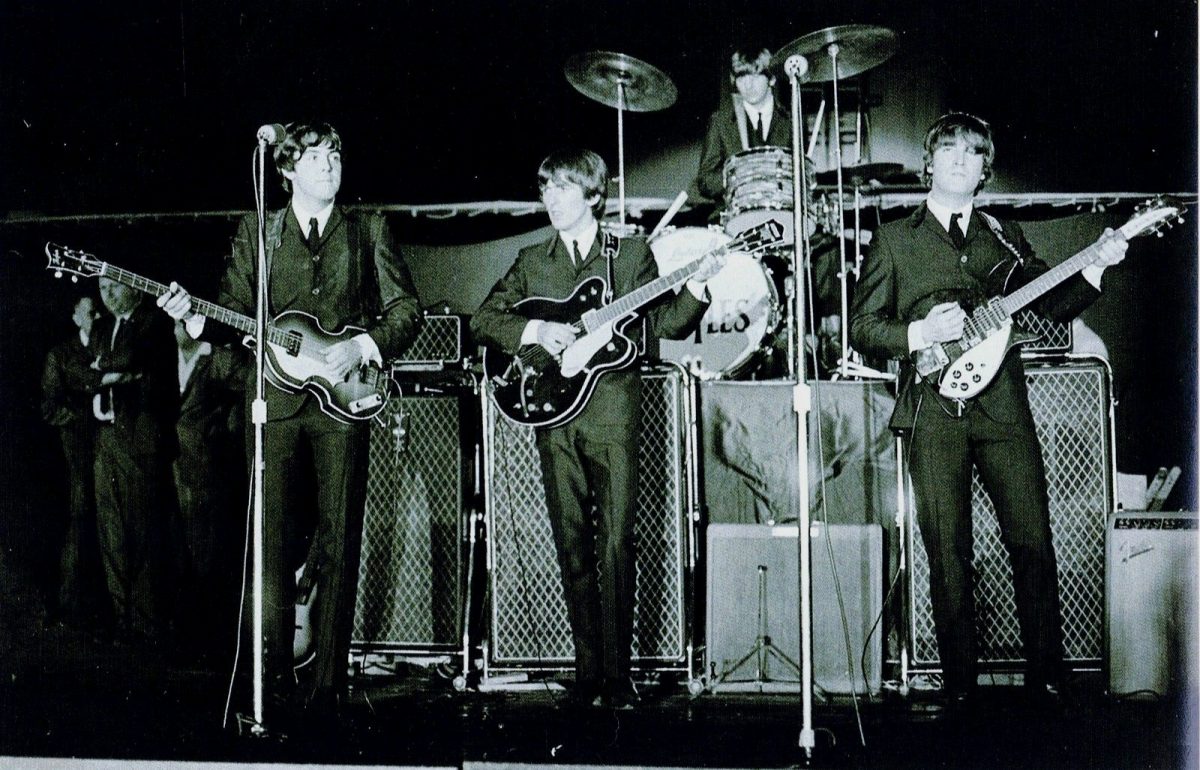
For the two-night engagement, each Beatles set’s duration was 30 minutes, and they exited by helicopter as quickly as they arrived. The Beatles earned $1,500 a minute on average. Police officers had counterfeiters on their radar due to confused seating arrangements, and fire officials charged that if the 500 folding chairs were not removed from the field, a concert would have been blocked. Jazz Clarinetist and bandleader, “King of Swing” Benny Goodman was in the audience, amused at the pandemonium, and felt he never saw anything quite like it in his wildest popularity heyday. Legendary actress Thelma Ritter, who was often spotted near her Forest Hills Gardens home at 65 Greenway Terrace, told the LI Star-Journal, “If I didn’t see it, I’d never believe it.”
A few years ago, an elder West Side Tennis Club member shared one of those unbelievable moments with Linna Hunt, a 47-year Club member and architect. “After The Beatles exited their helicopter which landed on the grass tennis courts, a young female fan quickly chained herself to the helicopter. With plans to fly back with The Beatles after the concert, the Club had to find a chainsaw to extricate her!”

After the concerts ended, the cleanup proved to be no ordinary challenge. The grass was concealed with boards, but Beatles fans managed to leave behind a trail. “I don’t know why, but I think it was a custom for fans to throw jelly beans at Ringo,” said Jim Sheridan, the WSTC groundskeeper for 54 years, who began to reminisce. “I was 14, had working papers, and I was only able to work at certain times, which consisted of no nights or when school was in session. I remember my father lamenting the jelly bean situation, where thousands of jelly beans were tossed all over. Overnight it rained, and there was a gooey mess on the courts the next morning. I also remember some fence damage from having a helicopter land on the grass courts.”
His late father, Owen Sheridan, who was the chief groundskeeper, told the Associated Press, “Jelly beans and broken glass slipped through the boards. We tried to suck them up with an industrial vacuum cleaner, but we couldn’t get them all.” He continued, “Finally, we had to hire 18 men working three full days to pick the jelly beans up one by one. The beans filled six 2-by-2 foot boxes.”

Fast-forward to 2018, some of the 32,000-plus concert attendees shared their experiences with exuberance. Forest Hills resident Janet Czerne Weiss recalled a challenge obtaining tickets. “I sent away for them almost immediately, and after several weeks received a letter stating that there were no more tickets, so my dad and I went to the ticket booth, spoke to someone, and we were able to get several tickets.” That was a wish come true for friends Bev and Wendy, fellow Beatlemaniacs, who decided to send The Beatles four Forest Hills High School sweatshirts. “I doubt they ever got them, but somewhere in the world, four people are walking around with FHHS sweatshirts,” she chuckled.
“My academic record the first year was affected by less time studying and more time listening to the Beatles. She recalled taking along their FHHS ‘Booster’ shakers, which certainly came in handy. “It’s palpable and very contagious, and even if you don’t want to scream, you can’t help yourself. There was a strange type of energy in that arena, and anywhere having to do with The Beatles.” She also has a vivid recollection of The Beatles circling in the helicopter. “This got everybody even more excited. The boys ran out onstage, started singing, and you were also kind of blinded by the thousands of camera flashes going off.”
Old Westbury resident Anne Kropf, who was raised in Forest Hills and graduated from FHHS in 1962, attended with her friends Judy and Carol of Oceanside, and had an up close and personal experience near the stage.“There was lots of screaming anytime one of them shook their head, making their hair move. They looked stunned sometimes and exchanged lots of looks of amazement. The fascination was partly the accents, partly the cute clean-cut look, and the clothes that were unlike what any of our American groups wore at the time. Many girls had a favorite Beatle, which made the music much more personal.” She takes pride in knowing that she owned all Beatles albums, and added, “I still have some of The Beatles trading cards.”
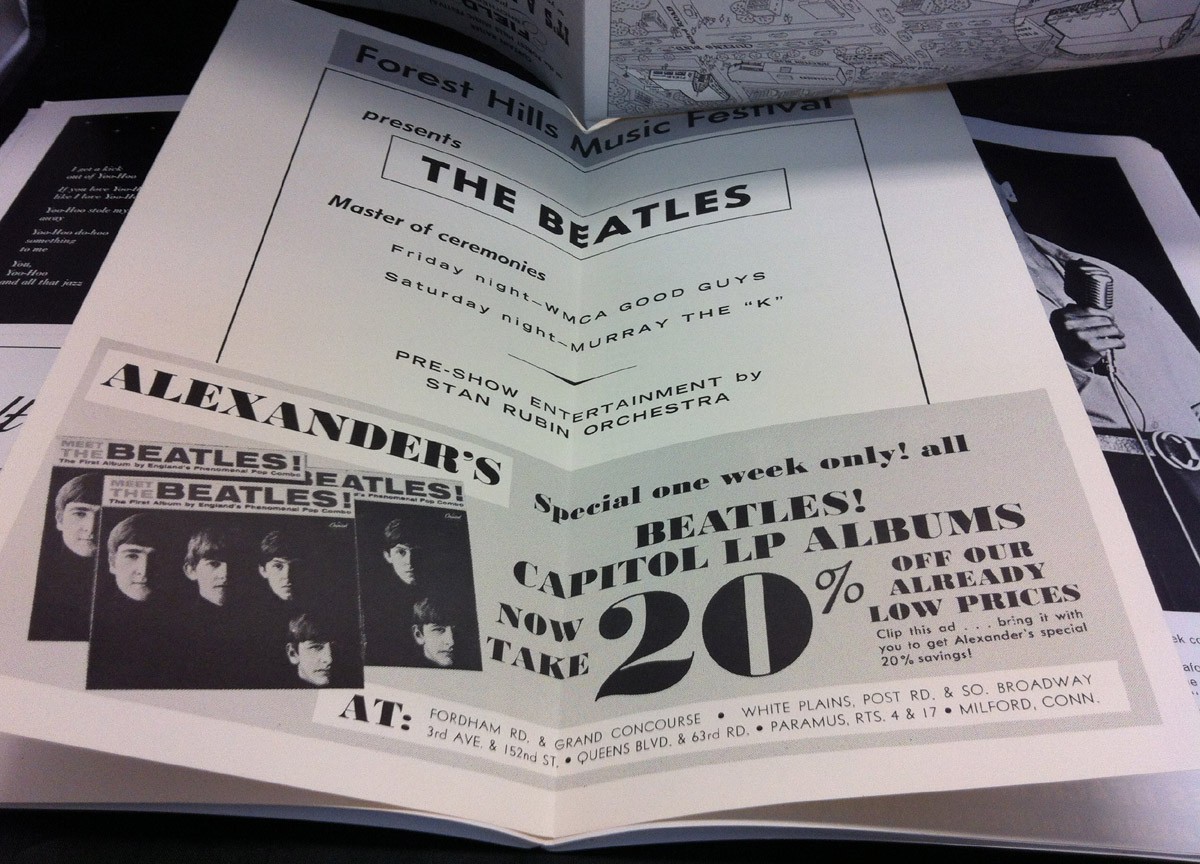
Jeannette Sinibaldi, a native Forest Hills resident who could not resist attending both nights, was joined by her friend Neme. They waited on line at the Queens Boulevard ticket office for the first concert, and for the second, they each offered the security guards $5. “They snuck us in, and that night, we also took my friend’s younger sister, who was in grammar school. We were in junior high school, came from good families with educated parents, and earned 50 cents an hour for babysitting, but my parents gave me the money and I was grateful. Kids were allowed to do things on their own without all the fears of today.” As a repetitive listener to Beatles records, she was ready for an eventful weekend with her father’s navy binoculars in hand, and then they made their way over the 67th Avenue footbridge, a frequent route. “I would listen to Murray the ‘K’ to keep track of their tour on my little transistor AM radio, which I saved up for with my birthday money. I was a ‘Paul girl.’ This was way before it all changed with Sgt. Pepper.”
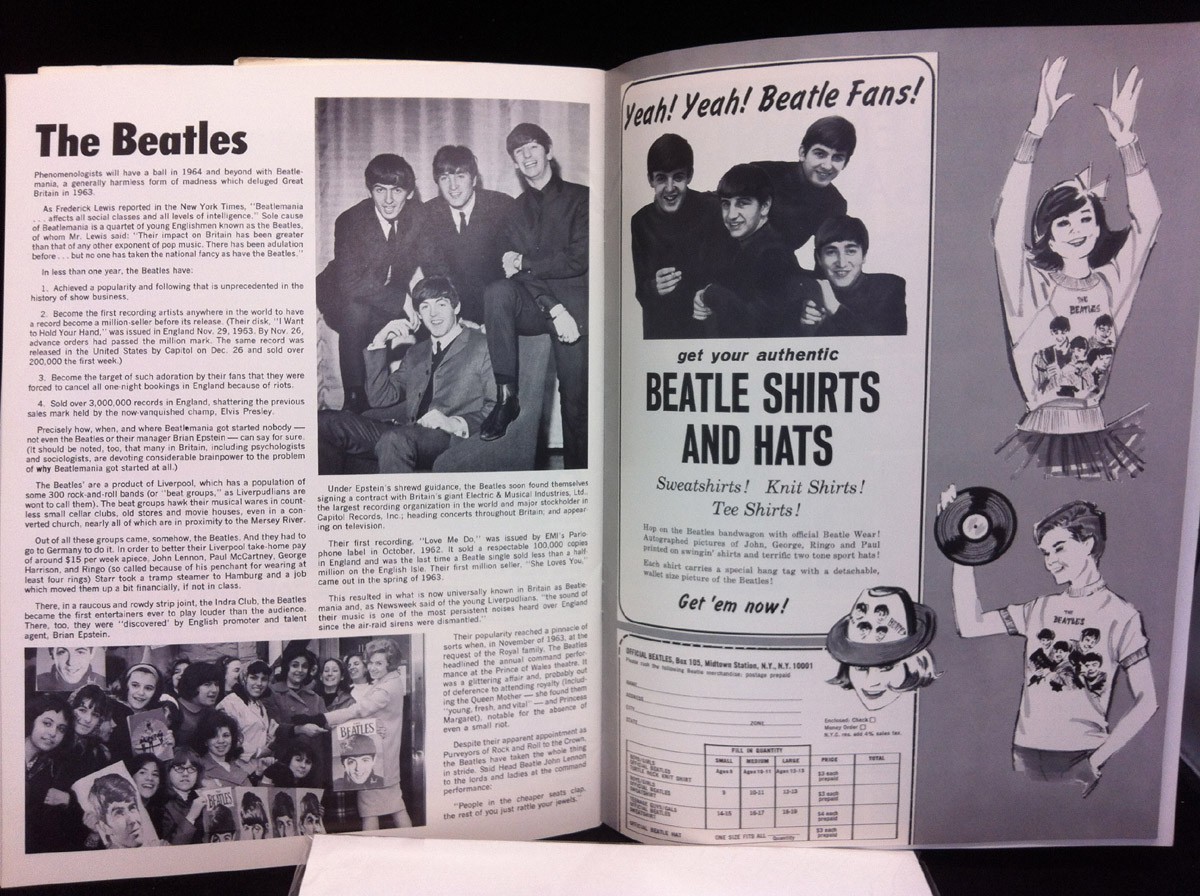
WSTC member and current Delray Beach, FL resident Bob Wolfang, who became a ball boy, score keeper, and served on the Board of Governors, first joined as a junior at 18 in 1964, the same year as the concerts. He reminisced, “My friends and I entered the Clubhouse, went out to the terrace, and snuck into the stadium, dodging the police in the dark. I remember an ivy-covered stadium and a dignified Club set against the Tudor style of Forest Hills. It attracted names such as Trini Lopez, Barbra Streisand, and Johnny Mathis (among that season’s performers), but despite all the musicians, The Beatles are ‘The Beatles.’” He continued, “They came in by helicopter, and if we would have realized what a moment in history that was, along with a performance of that magnitude, I can ask ‘Why didn’t we take a camera?’””
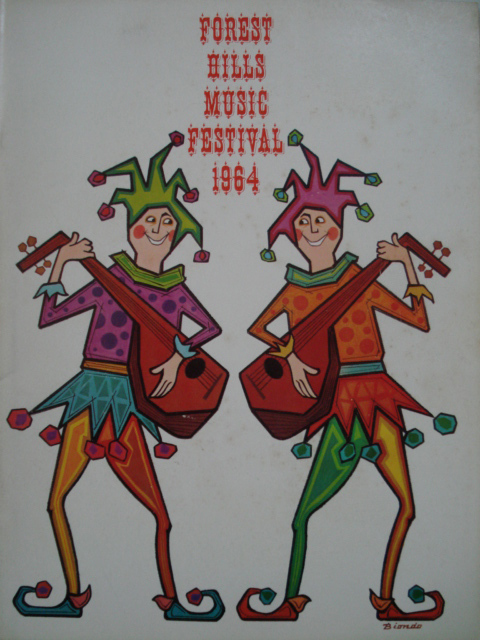
Her hair was similar to the group’s wives and girlfriends’ hair which was waist-length with long bangs, and she wore Yardley of London makeup which made her feel pretty. “The energy and frankly the insanity of the other Beatlemaniacs were electric! Sawhorses stood between us and the stage, and in front of us was a line of security with arms linked, but I would have never even tried to rush ahead. Since I had a well-known crush on Paul, mooning over him from 100 feet was just fine.” She wound up next to Russell Sage JHS 190 classmates. “Since I wore red-coral pants, my father spotted me on the news. His landlady just bought an RCA color TV, and since he repaired TV sets on the side, he was checking it out and saw me in living color. Then I got it with both barrels the next day, since my parents thought that ‘nice young ladies’ went to concerts and sat properly, but we were all so excited!”
She continued, “Even as I look back almost 54 years later, seeing them was the experience of a lifetime, and if you could see me smiling, you’d know even more. This was a genre of music which defined that phase of music, and my parents were convinced that ‘no one would even remember them in 5 years.’ Hah!”
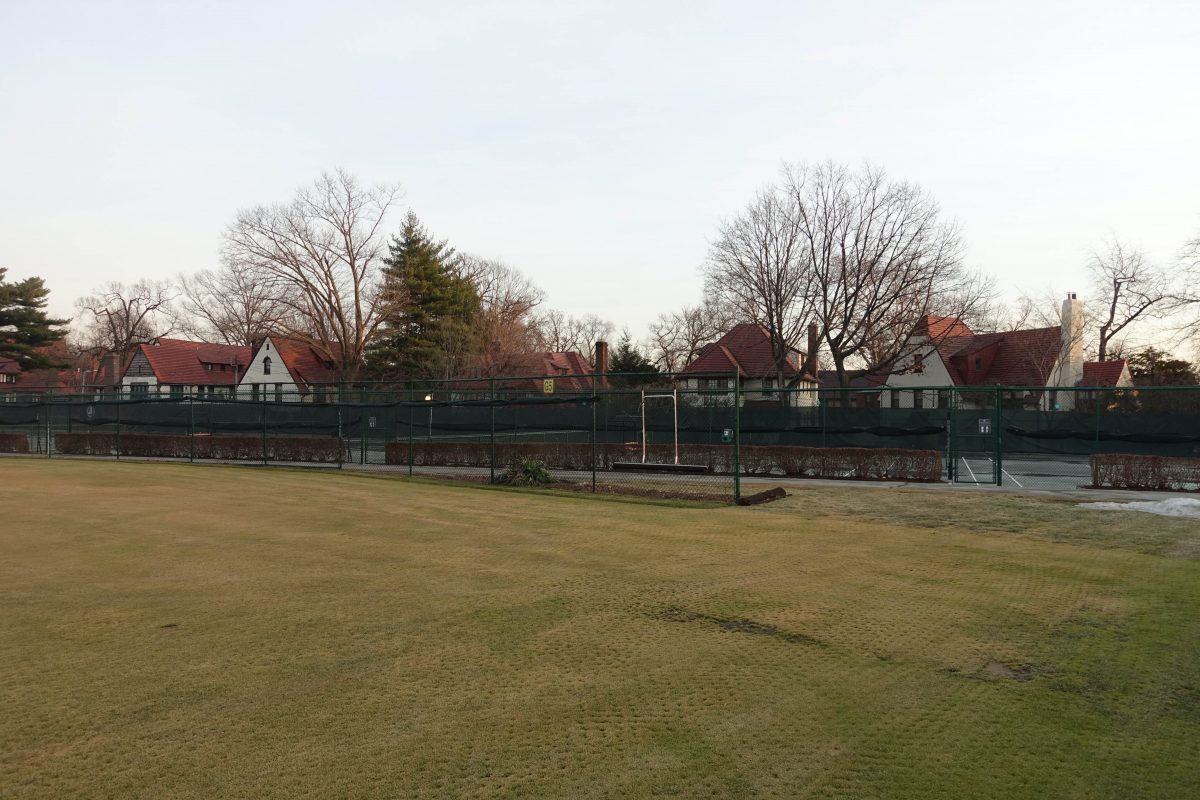
SPOTLIGHT ON FRANK SINATRA AT FOREST HILLS STADIUM
POSTED: DECEMBER 12, 2017

The Beatles, Simon & Garfunkel, Bob Dylan, Barbra Streisand, Diana Ross, The Who, Hall & Oates, and Santana are only a small percentage of the legendary singers that graced and rocked the historic Forest Hills Tennis Stadium since its adaptation as a concert venue in 1960. Among them was Sinatra, who had three concerts in 1965 and two in 1977.
The 1965 Forest Hills Music Festival marked Sinatra’s first commercial appearance in New York in eight years, and he opened its sixth season with shows on July 8, 9, and 10. The producers booked him for a third concert after an ad generated mass response by mail, and each gig was a complete sellout. For his nightly concerts, he reportedly received $40,000, since it was his intent to keep the ticket prices minimal to respect the budget of a more youthful crowd. With tickets available at $6.95, fans traveled in from Buffalo to Atlanta.
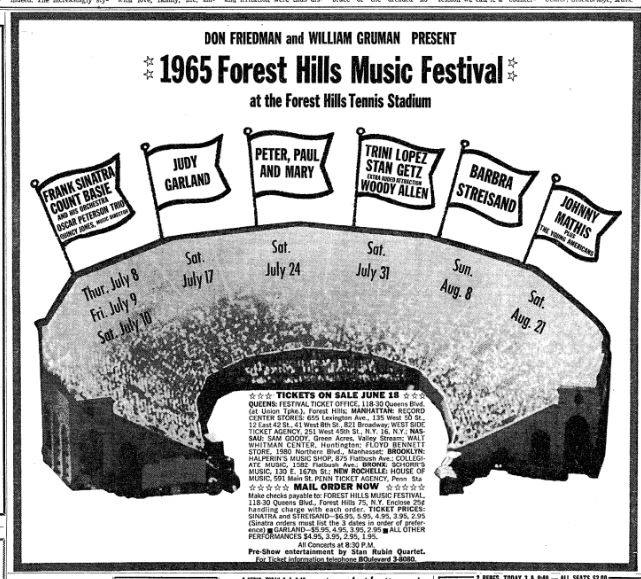
Count Basie opened the concert and then accompanied Sinatra, and the 16-piece band performed arrangements by conductor and composer Quincy Jones. It was the season’s opening night, and in front of a sold-out venue consisting of 15,000 concertgoers, Sinatra performed 20 standards in 90 minutes which included “Fly Me to the Moon,” “I’ve Got You Under My Skin,” “Luck Be a Lady,” and “I Only Have Eyes For You.” On “Hello, Dolly!,” Louis Armstrong, an internationally renowned jazz musician who resided in Corona, made an appearance, and Sinatra improvised “Hello, Louis.”
The audience, largely in their thirties and forties, got dressed up for the occasion, recalling the 1940s era when some fans were bobby-soxers in Manhattan’s Paramount, who would stand in line since early in the morning. Sinatra was charismatic, warm, and personable, and in response to his low notes, some female fans would once again let out squeals. Near the stadium was a saloon with a jukebox offering some Sinatra tunes of an even earlier era.
The previous weekend, Sinatra landed in a helicopter for his Newport Jazz Festival gig, and he hoped to make another landing at Forest Hills Stadium. This would have also evoked memories of The Beatles’ landing at the stadium in the summer of 1964, but the West Side Tennis Club decided to prioritize on keeping its lawn greener. Also hoping to exit by helicopter, Sinatra had no choice but to settle for a limo, and off to Manhattan he was.
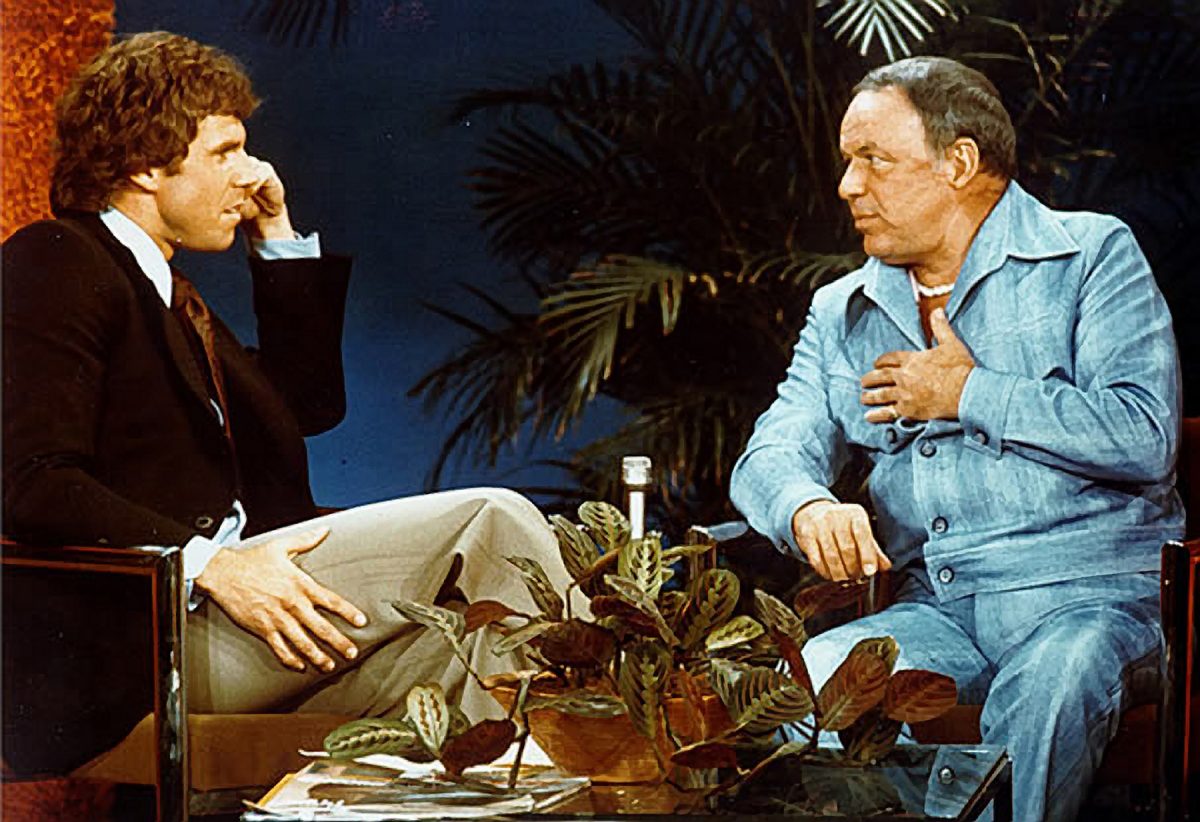
Television host Bill Boggs, who can be seen on BillBoggsTV on YouTube, has interviewed everyone from Frank Sinatra and Burt Bacharach to Lena Horne, Sammy Davis, Jr, and Barry Manilow throughout his career. He reminisced the July 10 concert. “In 1965, Frank was doing many recordings and consistently making movies, and it was rare for him to be performing a concert in a city at the time. If you wanted to see him live back then, it was basically Vegas or Miami. This was his first commercial gig in New York in eight years, so Forest Hills was special to him and the audiences. The Oscar Peterson Trio opened that show, and when Frank took the stage with Count Basie, a jolt of electric energy swept around the stadium.”
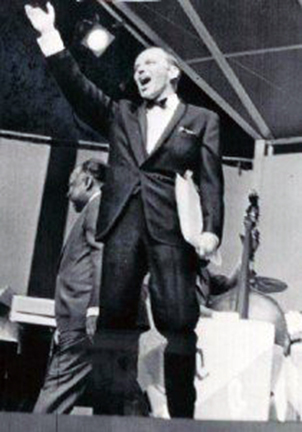
Boggs continued with a recollection of his mother seeing Sinatra as a bobby-soxer. “I asked what was so special when you first saw him, and she said ‘It felt like he was singing just for me.’ When I interviewed him, I mentioned it, and Frank said, ‘I try to put myself in the position of someone who would be experiencing what I’m singing about, and I try to make the case in that way.’” Boggs said that Sinatra’s ability as an actor enabled him to “inhabit” the lyrics.
In August 1965, as a cross-promotion between the Forest Hills Inn and the stadium, wet cement was sent to Sinatra in addition to Barbra Streisand, after rejecting to inset their handprints on site. After the blocks hardened, they were inserted at the Inn’s “Celebrity Sidewalk,” similar to the handprints outside Grauman’s Chinese Theatre.
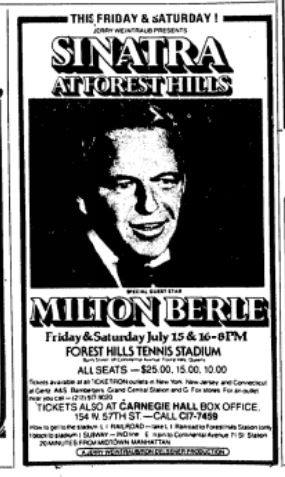
“I love that man!” said Forest Hills resident Gilda Flannery, a 1977 attendee. “He totally loved the outdoor venue, and the night was magic and the air… electric!” Hollywood resident Paul Mock, who owns every Sinatra commercial recording plus several very rare official recordings, calls himself a Sinatraphile. He said, “Sinatra was in very fine voice and great spirits, and no one came near to the energy that he exuded from the stage. Sinatra just completed filming ‘Contract on Cherry Street’ and had a gathering with those connected with the film post-concert offstage. I was blessed to have seen him 29 times between 1974 and 1991.”
Maryland resident Rae Finkelstein Treuhaft, formerly of Forest Hills, was in her late twenties at the time. She said, “Just seeing an icon was all that I needed. I saw different generations together, and everyone was enjoying the concert.” Despite a widespread New York City blackout that spanned two days prior and serial killer “Son of Sam” on the loose, attendees lived in the moment.


